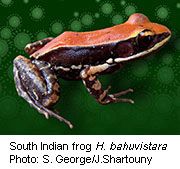
It sounds like weird science, but the slime that coats the skin of South Indian frogs might fight some strains of the flu.
A new mouse study suggests this is so, although research in animals frequently doesn’t pan out in humans.
What the researchers found was that certain peptides in the frogs’ skin mucus can destroy the H1 variety of influenza viruses.
It was known that frogs’ skin can secrete peptides that protect against bacteria. Peptides are short chains of amino acids, the building blocks of proteins. The new findings suggest these peptides could help lead to new antiviral treatments as well, the researchers said.
Such drugs could prove important when vaccines aren’t available to deal with new strains of pandemic flu, or when known flu strains develop resistance to current medications, said study senior author Joshy Jacob.
One of the peptides in the frogs’ skin mucus is called urumin. It protected unvaccinated mice against a lethal dose of H1 strains of flu, such as the 2009 pandemic strain. However, it was not effective against other current flu strains such as H3N2, the investigators found.
The study was published April 18 in the journal Immunity.
The researchers said they’re now trying to find ways to stabilize antiviral peptides such as urumin, and to identify other frog-derived peptides that can protect against other viruses, such as mosquito-borne dengue and Zika.
Jacob is an associate professor of microbiology and immunology at the Emory Vaccine Center in Atlanta. He made his comments in an Emory University news release.
More information
The U.S. Centers for Disease Control and Prevention has more on influenza.
Source: HealthDay

Leave a Reply